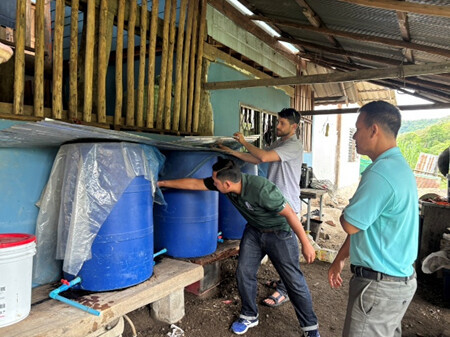ECHO Asia has completed our research into bio-sand water filtration systems.
Are they effective? Yes.
But, this comes with some clarifications.
Context:
ECHO Asia team collected water samples from 12 bio-sand filters in Northern Thailand

Checking bio-sand filter

Taking water sample for lab testing
Our results:
Community reports
We interviewed communities using the filters, who reported a reduction in illness associated with poor water quality after installation of the filters.
Sediment and color:
Filters reduced sediment in the water considerably. Often this reduced the colour and turbidity test results sufficiently to meet Thai Ministry of Health guidelines. However, for very dirty water, it often could not clean the water enough.
Taste and smell
Filtration improved taste and smell. For very dirty water, sometimes not enough to be palatable.
Salinity and calcium
The filters were not effective at removing salinity or high calcium levels in water
Iron
The filters were very effective at removing iron from the water
Metals and some anions
The filters generally made no difference or there was insufficient evidence as to their effectiveness on filtering many metals, and also non-metallic anions like sulfate, chloride, fluoride, and arsenic. There was insufficient evidence as pre-filtration levels in water was often low or non-existant.
Total coliform bacteria and Escherichia coli
Total coliform bacteria are a group of microorganisms found in soil, surface water, and the intestines of mammals. While most coliforms are harmless, their presence in drinking water can signal that the water supply may be contaminated with harmful pathogens from animal or human waste.
Bio-sand filters were effective in some cases at reducing total coliform bacteria, but not at eliminating them. Most of the tests only show presence or absence of coliforms, so this study cannot claim the filters consistently reduce coliforms. In some systems they reduced coliform bacteria counts to undetectable levels. Typically, coliform bacteria are present post filtration. In only one system coliforms were present prior to filtration and absent afterwards.
E. Coli in water indicates fecal contamination, meaning human or animal waste has entered the water supply. Some strains of E. Coli can cause illness in humans. E. Coli presence is a more reliable indicator of unhealthy microbes in water than Total Coliforms.
Most systems had no E. Coli in the water prior to filtration. There were two systems where filtration removed E. Coli. There was only one system with E. Coli after filtration.
Conclusion:
Bio-sand water filters are effective at improving water physical and microbial cleanliness. They can also remove iron from water. There are some quality parameters such as salinity that they may not be effective for.
Effective does not mean that they can treat water to within acceptable parameters for healthy drinking 100% of the time. This depends on the system design, the original water supply, maintenance of the filter, and several other factors. While filtration is very likely going to improve water quality, improvement may not be to levels that meet health standards.
Bio-sand water systems of the design promoted by ECHO Asia are an appropriate technology for community-level water treatment, where there is no current filtration. They will be better than no filtration. There is no one-size fits all recommendation on safety with self-assembled filters, with different water supplies and management. All surveyed communities using biosand filters drink water without boiling and have no issue with this. Boiling for sterilization before drinking is recommended if there are any concerns on water microbial quality.
More details coming up in an ECHO publication.
How do these results match your own experience with biosand filtration?


